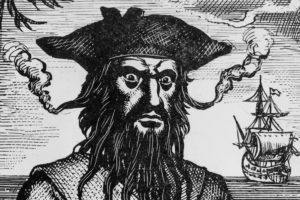
Pirates and Privateers on Long Island Sound
Part V
See part 1 here.
See part 2 here.
See part 3 here.
See part 4 here.
By Dan Shine
The pirate Blackbeard, whose proper name was Edward Teach, had great success and notoriety for years of plundering ships just of the coast of the Carolinas.
When our imaginations conjure up the image of the prototypical pirate from that age, it is most likely Blackbeard that we see: He was a wicked looking corsair, dressed in a long velvet coat, with six flintlock pistols riding in bandoleers across his chest, and with fuses of sulfur burning in his beard, to intimidate all who knew him.
In 1716 Blackbeard was made captain of a prize sloop, and retained the rank of captain for the rest of his pirating career. At times, pirate ships worked in fleets, and when that was the case, Blackbeard was first among his peers, overseeing the activities of the others. Predictably, along the way he became quite wealthy.
At one point, he gave up the pirating life, secured a royal pardon, and attempted to settle down on shore with his ill-gotten fortune. But the quiet life of a landed country gentleman was not for Blackbeard; soon he returned to pirating on the high seas, disrupting commerce, and becoming a growing annoyance to those who served the Crown.
It was on those high seas that Blackbeard met his fate–for by now, the colonial governor had commissioned Lieutenant Robert Maynard to assemble a crew of fearless sailors to put an end to Blackbeard and his pirating career. The day finally came when Maynard and his crew hunted down and boarded Blackbeard’s ship with the help of grappling hooks. Both pirates and sailors were armed with flintlock pistols, muskets and cutlasses, and both hacked away at each other with neither fear nor mercy. In the end, the victory went to Maynard and his men.
Blackbeard fought resolutely, despite numerous bullet wounds and deep cutlass lacerations—it seemed that he simply refused to die. But die he did: as Maynard’s cutlass severed his head from his body, Blackbeard finally gave up the ghost and departed this life. His head was attached to the bowsprit of Maynard’s ship, both as a trophy and as a warning to others.
One treasure story persists: Blackbeard is said to have come once to Connecticut’s coast on his ship, “Queen Ann’s Revenge,” which was laden with the spoils of his most recent exploits. Landing at New London, he and his crew followed a track that led toward Boston, with a cache of gold, silver and jewels. Finally, they dug an elaborate, granite-walled excavation, and deposited their treasure therein. Afterwards, they departed and sailed south, to meet their destiny at the hands of Lieutenant Maynard.
Was their treasure ever found? We will never know; for as it is said, “Dead men tell no tales.” And anyone who might have known is long gone.